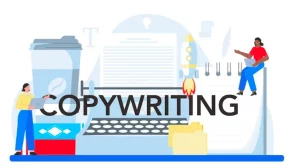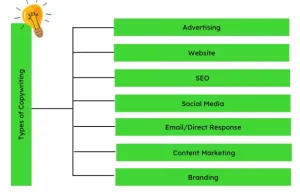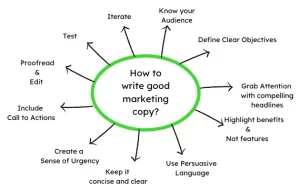What is Copywriting? How to Create a Compelling Copy?
A great copywriting example can be Airbnb. It says, “Live like a local” and “Belong anywhere,” which inspires and leaves a wanderlust impressed with phrases.
Similarly, “Welcome Home” evokes a sense of comfort and belonging, appealing to travellers seeking authentic and immersive experiences. Their listings feature compelling descriptions that paint vivid pictures of unique accommodations, enticing users to explore new destinations and book their stay.
Airbnb successfully creates a sense of adventure, community, and personal connection through its copy, making them a standout example of excellent brand copywriting.
If this intrigues you probably understand how words help brands communicate with their target audience.
Read ahead to know what is copywriting?
What is Copywriting?
Copywriting is the art and science of creating persuasive and compelling written content to promote a product, service, or idea. It involves crafting impactful headlines, engaging body copy, and compelling calls to action.

- Copywriters employ strategic language, storytelling techniques, and persuasive tactics to capture the target audience’s attention, convey the value and benefits of the offering, and ultimately drive the desired action, such as making a purchase or subscribing to a service.
- Copywriting can be used in various mediums, including advertisements, websites, social media posts, emails, brochures, and more, to effectively communicate a message and elicit a response from the audience.
- It is a copywriter who creates a compelling sales ad copy. Sales copy meaning is to strategically and persuasively communicate the value, benefits, and unique selling points of a product, service, or offering to convince and motivate the target audience to make a purchase or take a desired action.
- It aims to engage readers, address their needs or pain points, overcome objections, and create a sense of urgency or desire, ultimately driving conversions and generating revenue for the business.
Also Read: 30 Unique Content Marketing Ideas
What Does it Mean by a Compelling Copy?
A compelling copy refers to written content that captures and holds the audience’s attention, sparking their interest and motivating them to take action. It goes beyond simply conveying information; it aims to emotionally resonate with readers, create a connection, and persuade them to engage further. A compelling copy is persuasive, convincing, and impactful.

It uses compelling language, storytelling techniques, and a deep understanding of the target audience to effectively communicate the value and benefits of a product, service, or idea. It evokes emotions, addresses pain points, and presents a solution that leaves the reader compelled to act, whether purchasing, subscribing, sharing, or taking any desired action.
Types of Copywriting
There are several types of copywriting, each serving a specific purpose and targeting different audiences. Here are some common types of copywriting:

Advertising Copywriting:
This type focuses on creating persuasive and attention-grabbing copy for advertisements across various media channels such as print, digital, radio, or television. It aims to drive brand awareness, promote products or services, and generate leads or sales.
Website Copywriting:
Website copy is written to engage and inform visitors about a company, its offerings, and its values. It includes homepages, landing pages, product descriptions, about pages, and other website content designed to capture attention, communicate benefits, and encourage conversions.
SEO Copywriting:
SEO copywriting involves creating content that is optimised for search engines while also being engaging for readers. It includes incorporating relevant keywords, writing meta tags, headers, and descriptions, and creating informative and valuable content that ranks well in search engine results.
Social Media Copywriting:
Social media copy is designed to captivate and engage audiences on platforms like Facebook, Instagram, Twitter, and LinkedIn. It focuses on a concise, attention-grabbing copy, accompanied by visual content, to drive engagement, encourage sharing, and generate brand awareness.
Email Copywriting:
Email copywriting is used to craft persuasive and personalised messages sent to a targeted audience via email marketing campaigns. The goal is to grab the reader’s attention, convey a compelling message, and prompt them to act, such as purchasing or subscribing.
Direct Response Copywriting:
Direct response copy is created to generate an immediate response or action from the reader. It often includes sales letters, direct mail pieces, or landing pages with persuasive copy, strong calls to action, and offers that encourage immediate responses.
Content Marketing Copywriting:
Content marketing copy involves creating informative, valuable, and engaging content such as blog posts, articles, guides, or whitepapers. The aim is to provide helpful information, build trust, establish thought leadership, and attract and retain an audience.
Branding Copywriting:
Branding copy focuses on creating a unique brand voice, tone, and personality that resonates with the target audience. It includes taglines, brand messaging, slogans, and other elements that convey the brand’s values, identity, and differentiation.
Things To Keep in Mind When Writing A Good Marketing Copy.
These are the things that you can keep in mind when creating a good marketing copy:

Know Your Target Audience:
Understand your audience’s demographics, interests, needs, and pain points. Tailor your copy to resonate with them and address their specific challenges or desires.
Clearly Define the Objective:
Determine the purpose of your marketing copy. Whether to drive sales, generate leads, increase brand awareness, or educate, clarity on the objective will help you craft-focused and compelling copy.
Grab Attention with Compelling Headlines:
Capture the reader’s attention with attention-grabbing headlines. Use powerful words, ask questions, or make intriguing statements to entice them to read further.
Highlight Benefits, Not Just Features:
Focus on your product or service’s benefits rather than just listing its features. Show how it solves a problem, improves their life, or fulfils a specific need.
Use Persuasive Language:
Use persuasive techniques like storytelling, emotional appeal, and social proof to engage readers emotionally. Make them feel connected to your brand and compelled to take action.
Keep it Clear and Concise:
Write clearly and concisely. Use simple and easily understandable language. Break the text into paragraphs, use bullet points, and highlight key information to enhance readability.
Create a Sense of Urgency:
Encourage immediate action by creating a sense of urgency in your copy. Limited-time offers exclusive deals, or scarcity tactics can motivate readers to take action sooner rather than later.
Include Strong Call-to-Actions (CTAs):
Clearly guide readers on what action to take next. Use robust and action-oriented language in your CTAs to encourage conversions. Make it easy for readers to understand how to proceed.
Proofread and Edit:
Avoid grammatical errors, typos, and unclear phrasing. Proofread your copy carefully to ensure it is polished and error-free. Edit for clarity and conciseness, removing any unnecessary words or jargon.
Test and Iterate:
Continuously test different versions of your marketing copy to determine what resonates best with your audience. Analyse the results, gather feedback, and make necessary adjustments to improve its effectiveness.
Brand Example that Creates Compelling Sales Copy
Reading a compelling brand copy is Coca-Cola’s “Open Happiness” campaign. Coca-Cola taps into the universal desire for joy and happiness with this tagline. The copy emphasises the brand’s ability to create moments of joy, connection, and shared experiences.
It evokes a sense of nostalgia, warmth, and optimism, appealing to the audience’s emotions. Coca-Cola’s copywriting not only focuses on the product itself but also highlights its brand’s emotional benefits and positive feelings, making it compelling and relatable to consumers worldwide.
Conclusion
Copywriting is the art of crafting persuasive and engaging written content that captivates audiences and drives desired actions. It is the key to effectively communicating your message through advertisements, websites, or social media.
To create compelling ad copy that captures attention and delivers results, connect with us at hello[at]noboruworld.com. Our experienced team of copywriters is ready to help you unleash the power of words and create impactful campaigns that resonate with your target audience. Take advantage of the opportunity to elevate your brand and drive success through the art of copywriting. Contact us today!
FAQ
What is copywriting?
Copywriting is crafting persuasive and compelling written content to promote a product, service, or idea. It involves using strategic language and storytelling techniques to engage the target audience and motivate them to take a specific action.
Why is copywriting important?
Copywriting plays a crucial role in marketing and advertising. It helps businesses effectively communicate their message, build brand awareness, engage customers, and drive conversions and sales. A well-crafted copy can captivate audiences, evoke emotions, and compel them to take the desired action.
What skills are needed for copywriting?
Effective copywriting requires creativity, excellent writing skills, and a deep understanding of the target audience. Copywriters should be able to convey a clear message, employ persuasive techniques, and adapt their writing style to different mediums and audiences.
How can I improve my copywriting skills?
Improving copywriting skills involves continuous learning and practice. Studying successful copywriting examples, reading books on the subject, and taking courses or workshops can be helpful. Additionally, seeking feedback from peers or professionals in the field can provide valuable insights for growth.
What makes copywriting persuasive?
Persuasive copywriting involves understanding the needs and desires of the target audience and addressing them effectively. It utilises compelling headlines, engaging storytelling, emotional appeal, social proof, and strong calls to action to convince readers and drive them toward the desired outcome.
Can copywriting work for any industry or business?
Yes, copywriting can be effective for any industry or business. Whether selling products, providing services, or promoting a cause, a well-crafted copy can help you connect with your audience, differentiate your brand, and communicate your value.
Should I hire a professional copywriter?
Hiring a professional copywriter can be beneficial, especially if you lack the in-house time, expertise, or resources to create compelling content. A professional copywriter can bring a fresh perspective, industry knowledge, and expertise in crafting persuasive copy that resonates with your target audience.



